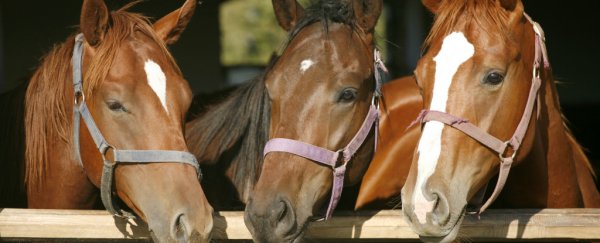Scientists in Norway say they've trained horses to communicate with humans, by pointing their muzzle at simple symbols on a board.
The horses were asked whether they wanted to wear a rug or not, and their answers matched up with the weather outside, suggesting that they weren't just pointing randomly.
If this is confirmed as genuine communication between species, horses will join a small group of animals known to be able to communicate with humans through symbols, including dolphins, pigeons, and apes.
"I think our study adds to the knowledge on horse cognition - about what horses are able to learn and how they think," lead researcher Cecilie Mejdell, from the Norwegian Veterinary Institute, told Helen Briggs over at BBC News.
"Horses are often considered to be not very intelligent but this shows that using the right methods they can actually communicate and express their opinions and they can take choices that seem sensible to us even."
The team trained 23 horses of various breeds to communicate by enticing them with carrots. First the horses were encouraged just to come up to the board and touch it with their muzzles.
They were then trained to differentiate between the three symbols available: a horizontal bar to represent they wanted their blanket on, a vertical bar if they wanted their blanket off, and a blank symbol if they wanted no change in their rug situation.
You can see an example of the horses making their choices below:
 Mejdell et al, Applied Animal Behaviour Science
Mejdell et al, Applied Animal Behaviour Science
After being taught to associate each symbol with its meaning, the horses were eventually able to walk up to the board and indicate if they were too hot or too cold with their muzzle. After two weeks of 10 to 15 minutes of training each day, all 23 horses could master this technique.
Rather than making random choices with their pointing ability, the team showed that the horses asked to have a blanket on when the weather was wet and cold, but wanted to have it off when it was sunny outside.
This suggests that they were using the symbols to communicate their real preferences - although, more work is needed to back up this assumption.
Still, it's not the first time that horses have been shown to be able to understand what humans are thinking - a study earlier this year showed that our equine friends might be able to read our moods just by looking at our faces.
"We have known for a long time that horses are a socially sophisticated species but this is the first time we have seen that they can distinguish between positive and negative human facial expressions," said lead author of that study, Amy Smith, from the University of Sussex in the UK.
Despite the fact that horses were domesticated around 5,000 years ago, and have lived alongside humans ever since, their communicative abilities have largely been ignored by science up until now. But these early results suggest that they're a lot more clever than previously thought.
The coolest part is that the researchers think ordinary horse owners could train their horses in the same way to gain insight into what they're thinking. The research could also be used in animal welfare.
"This is a really interesting and innovative study that has conceived a very novel way of getting at what is going on in the mind of the horse," Karen McComb, professor of animal behaviour and cognition at the University of Sussex, told the BBC.
The research has been published in Applied Animal Behaviour Science.
